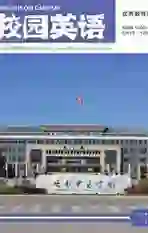Thematic Progression and Textual Coherence in Speech
2014-07-04周云鹤
周云鹤
【Abstract】Thematic progression can affect the flow of information and directly affect the discourse coherence. This paper analyzes thematic progression patterns of a speech about “people and nature” in the “CCTV Cup”English Speaking Contest and finds that there are three progression patterns in this text, which are parallel progression, continuous progression, and crossing progression.
【Key words】Thematic progression; Textual Coherence
This paper analyzes thematic progression patterns of a speech in the “CCTV Cup”English Speaking Contest and finds that there are three progression patterns in this text, which are parallel progression, continuous progression, and crossing progression.
1.Parallel Progression:Every sentence starts from the theme of the first sentence.
After my continued efforts, I was able to play a lot of musical pieces very soon. I felt so proud of myself that I began to behave arrogantly.
2.Continuous Progression: The rheme or part of rheme is the theme of the next sentence.
I began learning to play the violin when I was eight years old. At first, it was a very hard thing for me.
3.Crossing Progression: The theme of the first sentence is the rheme of the second sentence, the theme of the second sentence is the rheme of the next sentence, etc.
I felt so proud of myself that I began to behave arrogantly. My violin teacher noticed this and told me: “To be a good violin player, you should first of all love and respect your violin.
The speech is composed of four paragraphs. Although there are no linking words such as "first, second, third", the structure of the speech is still clear. Transitions between each paragraph are natural. There are 17 themes in the text in total. Through these 17 themes, we can clearly see the development of the ideas of the speaker. In the first paragraph, speaker links the topic to his own story to attract the attention of the audience (T1, T2, and T3). The speaker tells his own story (T4, T5, and T6). T7, T8, T9 and T10 compare the relationship between the speaker and the violin to the relationship between people and nature, recalling the topic. The speaker then makes appeals to protect nature (T11 and T12) followed by the measures we should take (T13, T14 and T15). The relationship between the speaker and the violin and the relationship between people and nature are mentioned again (T16). T17 recalls the topic and ends the speech. The passage is well organized and sentences and paragraphs are closely connected which makes the whole discourse coherent.
We can see the thematic patterns in this text are as follows:
From the table above, it can be seen that the parallel progression is the most frequently used in this text, then the continuous progression. Crossing progression only appears one time. During the flow of information, the speaker usually chooses the theme of the last sentence as the theme of the next sentence, which makes the parallel progression the one most frequently used. The use of continuous progression and crossing progression makes this passage well connected and coherent.
To sum up, in the whole discourse, thematic progression can affect the flow of information; make the discourse maintain semantic association. The thematic progression patterns used in this passage directly affects the discourse coherence.
